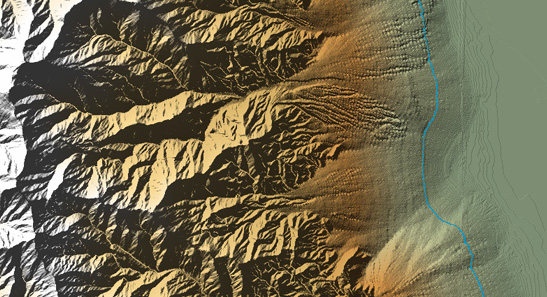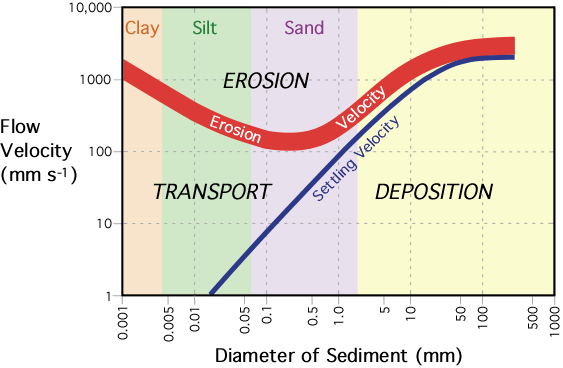Introduction
Erosion is defined as the removal of soil, sediment, regolith, and rock fragments from the landscape. Most landscapes show obvious evidence of erosion. Erosion is responsible for the creation of hills and valleys. It removes sediments from areas that were once glaciated, shapes the shorelines of lakes and coastlines, and transports material downslope from elevated sites. In order for erosion to occur three processes must take place: detachment, entrainment and transport. Erosion also requires a medium to move material. Wind, water, and ice are the mediums primarily responsible for erosion. Finally, the process of erosion stops when the transported particles fall out of the transporting medium and settle on a surface. This process is called deposition. Figure 10w-1 illustrates an area of Death Valley, California where the effects of erosion and deposition can be easily seen.

| Figure 10w-1: The following image was created from DEMs (Digital Elevation Model) for the following 1:24,000 scale topographic quadrangles: Telescope Peak, Hanaupah Canyon, and Badwater, California. To the left is the Panamint Mountain Range. To the right is Death Valley. Elevation spans from 3368 to -83meters and generally decreases from left to right. The blue line represents an elevation of 0 meters. Large alluvial fans extending from a number of mountain valleys to the floor of Death Valley can be seen in the right side of the image. The sediments that make up these depositional features came from the weathering and erosion of bedrock in the mountains located on the left side of the image. (This image was created with MacDEM software). |
Energy of Erosion
The energy for erosion comes from several sources. Mountain building creates a disequilibrium within the Earth's landscape because of the creation of relief. Gravity acts to vertically move materials of higher relief to lower elevations to produce an equilibrium. Gravity also acts on the mediums of erosion to cause them to flow to base level.
Solar radiation and its influence on atmospheric processes is another source of energy for erosion. Rainwater has a kinetic energy imparted to it when it falls from the atmosphere. Snow has potential energy when it is deposited in higher elevations. This potential energy can be converted into the energy of motion when the snow is converted into flowing glacial ice. Likewise, the motion of air because of differences in atmospheric pressure can erode surface material when velocities are high enough to cause particle entrainment.
The Erosion Sequence
Erosion can be seen as a sequence of three events: detachment, entrainment, and transport. These three processes are often closely related and sometimes not easy distinguished between each other. A single particle may undergo detachment, entrainment, and transport many times.
Detachment
Erosion begins with the detachment of a particle from surrounding material. Sometimes detachment requires the breaking of bonds which hold particles together. Many different types of bonds exist each with different levels of particle cohesion. Some of the strongest bonds exist between the particles found within igneous rocks. In these materials, bonds are derived from the growth of mineral crystals during cooling. In sedimentary rocks, bonds are weaker and are mainly caused by the cementing effect of compounds such as iron oxides, silica, or calcium. The particles found in soils are held together by even weaker bonds which result from the cohesion effects of water and the electro-chemical bonds found in clay and particles of organic matter.
Physical, chemical, and biological weathering act to weaken the particle bonds found in rock materials. As a result, weathered materials are normally more susceptible than unaltered rock to the forces of detachment. The agents of erosion can also exert their own forces of detachment upon the surface rocks and soil through the following mechanisms:
Plucking: ice freezes onto the surface, particularly in cracks and crevices, and pulls fragments out from the surface of the rock.
Cavitation: intense erosion due to the surface collapse of air bubbles found in rapid flows of water. In the implosion of the bubble, a micro-jet of water is created that travels with high speeds and great pressure producing extreme stress on a very small area of a surface. Cavitation only occurs when water has a very high velocity, and therefore its effects in nature are limited to phenomenon like high waterfalls.
Raindrop impact: the force of a raindrop falling onto a soil or weathered rock surface is often sufficient to break weaker particle bonds. The amount of force exerted by a raindrop is a function of the terminal velocity and mass of the raindrop.
Abrasion: the excavation of surface particles by material carried by the erosion agent. The effectiveness of this process is related to the velocity of the moving particles, their mass, and their concentration at the eroding surface. Abrasion is very active in glaciers where the particles are firmly held by ice. Abrasion can also occur from the particles held in the erosional mediums of wind and water.
Entrainment
Entrainment is the process of particle lifting by the agent of erosion. In many circumstances, it is hard to distinguish between entrainment and detachment. There are several forces that provide particles with a resistance to this process. The most important force is frictional resistance. Frictional resistance develops from the interaction between the particle to its surroundings. A number of factors increase frictional resistance, including: gravity, particle slope angle relative to the flow direction of eroding medium, particle mass, and surface roughness.
Entrainment also has to overcome the resistance that occurs because of particle cohesive bonds. These bonds are weakened by weathering or forces created by the erosion agent (abrasion, plucking, raindrop impact, and cavitation).
Entrainment Forces
The main force reponsible for entrainment is fluid drag. The strength of fluid drag varies with the mass of the eroding medium (water is 9000 times more dense than air) and its velocity. Fluid drag causes the particle to move because of horizontal force and vertical lift. Within a medium of erosion, both of these forces are controlled by velocity. Horizontal force occurs from the push of the agent against the particle. If this push is sufficient to overcome friction and the resistance of cohesive bonds, the particle moves horizontally. The vertical lift is produced by turbulence or eddies within the flow that push the particle upward. Once the particle is lifted the only force resisting its transport is gravity as the forces of friction, slope angle, and cohesion are now non-existent. The particle can also be transported at velocities lower than the entrainment velocities because of the reduction in forces acting on it.
Many hydrologists and geomorphologists require a mathematical model to predict levels of entrainment, especially in stream environments. In these highly generalized models, the level of particle entrainment is relative to particle size and the velocity of the medium of erosion. These quantitative models can be represented graphically. On these graphs, the x-axis represents the log of particle diameter, and the y-axis the log of velocity. The relationship between these two variables to the entrainment of particles is described by a curve, and not by a straight line.
The critical entrainment velocity curve suggests that particles below a certain size are just as resistant to entrainment as particles with larger sizes and masses (Figure 10w-2). Fine silt and clay particles tend to have higher resistance to entrainment because of the strong cohesive bonds between particles. These forces are far stronger than the forces of friction and gravity.

| Figure 10w-2: This graph describes the relationship between stream flow velocity and particle erosion, transport, and deposition. The curved line labeled "erosion velocity" describes the velocity required to entrain particles from the stream's bed and banks. The erosion velocity curve is drawn as a thick line because the erosion particles tends to be influenced by a variety of factors that changes from stream to stream. Also, note that the entrainment of silt and clay needs greater velocities then larger sand particles. This situation occurs because silt and clay have the ability to form cohesive bounds between particles. Because of the bonding, greater flow velocities are required to break the bonds and move these particles. The graph also indicates that the transport of particles requires lower flow velocities then erosion. This is especially true of silt and clay particles. Finally, the line labeled "settling velocity" shows at what velocity certain sized particles fall out of transport and are deposited. |
Transport
Once a particle is entrained, it tends to move as long as the velocity of the medium is high enough to transport the particle horizontally. Within the medium, transport can occur in four different ways:
- Suspension is where the particles are carried by the medium without touching the surface of their origin. This can occur in air, water, and ice.
- Saltation is where the particle moves from the surface to the medium in quick continuous repeated cycles. The action of returning to the surface usually has enough force to cause the entrainment of new particles. This process is only active in air and water.
- Traction is the movement of particles by rolling, sliding, and shuffling along the eroded surface. This occurs in all erosional mediums.
- Solution is a transport mechanism that occurs only in aqueous environments. Solution involves the eroded material being dissolve and carried along in water as individual ions.
Particle weight, size, shape, surface configuration, and medium type are the main factors that determine which of these processes operate.
Deposition
The erosional transport of material through the landscape is rarely continuous. Instead, we find that particles may undergo repeated cycles of entrainment, transport, and deposition. Transport depends on an appropriate balance of forces within the transporting medium. A reduction in the velocity of the medium, or an increase in the resistance of the particles may upset this balance and cause deposition. Reductions in competence can occur in a variety of ways. Velocity can be reduced locally by the sheltering effect of large rocks, hills, stands of vegetation or other obstructions. Normally, competence changes occur because of large scale reductions in the velocity of flowing medium. For wind, reductions in velocity can be related to variations in spatial heating and cooling which create pressure gradients and wind. In water, lower velocities can be caused by reductions in discharge or a change in the grade of the stream. Glacial flows of ice can become slower if precipitation input is reduced or when the ice encounters melting. Deposition can also be caused by particle precipitation and flocculation. Both of these processes are active only in water. Precipitation is a process where dissolved ions become solid because of changes in the temperature or chemistry of the water. Flocculation is a chemical process where salt causes the aggregation of minute clay particles into larger masses that are too heavy to remain suspended.